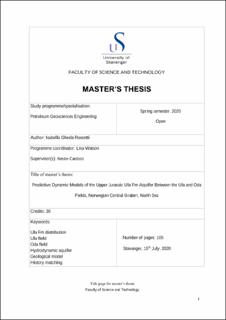| dc.contributor.advisor | Cardozo, Nestor | |
| dc.contributor.author | Ghesla Rossetti, Isabella | |
| dc.date.accessioned | 2020-10-13T09:03:26Z | |
| dc.date.available | 2020-10-13T09:03:26Z | |
| dc.date.issued | 2020-07-15 | |
| dc.identifier.uri | https://hdl.handle.net/11250/2682383 | |
| dc.description | Master's thesis in Petroleum Geosciences Engineering | en_US |
| dc.description.abstract | The Ula and Oda oil fields in the southern part of the Norwegian Central Graben have high quality Upper Jurassic sandstone reservoirs from the shallow marine Ula Fm. Pressure data from the Oda field indicates communication between the Ula and Oda fields through an aquifer in the Ula Fm. Through dynamic modelling of the Ula Fm aquifer, the communication between the Ula and Oda fields along this unit is evaluated. The models incorporate pressure and production data and are essential to understand reservoir depletion in the area.
The applied methodology integrates previous studies about the Ula Fm distribution, static and dynamic modelling of different scenarios, and history matching of the Ula field production and pressure data. Three scenarios for the Ula Fm fairway involve a possible communication between the Ula and Oda fields. Each scenario varies the size of the aquifer based on different hypothesis about the deposition and distribution of the Ula Fm. The most accepted scenario suggests that the Ula Fm was deposited in pod-shaped minibasins above salt walls and within the shoreface zone delimited by well data.
Dynamic modelling and history matching show that even in the scenario with the narrowest Ula Fm above the salt walls and sealing faults, there is still a channel communicating the Ula and Oda fields, and the production effects of the Ula field are “felt” by the Oda field. Therefore, there is strong geological and reservoir modelling evidence of communication between the Ula and Oda fields through an aquifer in the Ula Fm.
A geological model for the communication between the Ula and Oda fields through the Ula Fm is proposed. This model can be used to evaluate the risks related to the presence of a hydrodynamic aquifer in the Ula Fm, indicate new prospects in the Central Graben area, and optimize the development of the Oda field. | en_US |
| dc.language.iso | eng | en_US |
| dc.publisher | University of Stavanger, Norway | en_US |
| dc.relation.ispartofseries | Masteroppgave/UIS-TN-IER/2020; | |
| dc.rights | Navngivelse 4.0 Internasjonal | * |
| dc.rights.uri | http://creativecommons.org/licenses/by/4.0/deed.no | * |
| dc.subject | petroleumsgeologi | en_US |
| dc.subject | Ula Fm distribution | en_US |
| dc.subject | Ula field | en_US |
| dc.subject | Oda field | en_US |
| dc.subject | hydrodynamic aquifer | en_US |
| dc.subject | geological model | en_US |
| dc.subject | history matching | en_US |
| dc.title | Predictive Dynamic Models of the Upper Jurassic Ula Fm Aquifer Between the Ula and Oda Fields, Norwegian Central Graben, North Sea | en_US |
| dc.type | Master thesis | en_US |
| dc.subject.nsi | VDP::Matematikk og Naturvitenskap: 400::Geofag: 450::Petroleumsgeologi og -geofysikk: 464 | en_US |
| dc.subject.nsi | VDP::Teknologi: 500::Berg‑ og petroleumsfag: 510::Geoteknikk: 513 | en_US |

